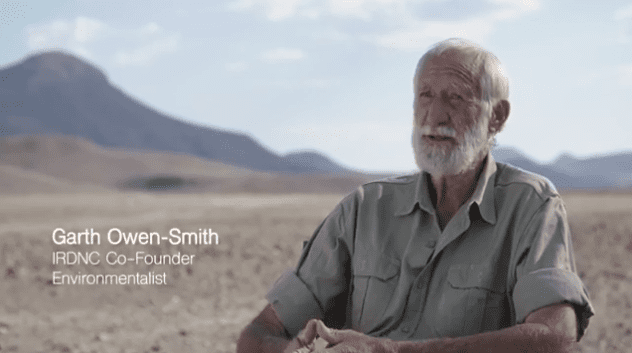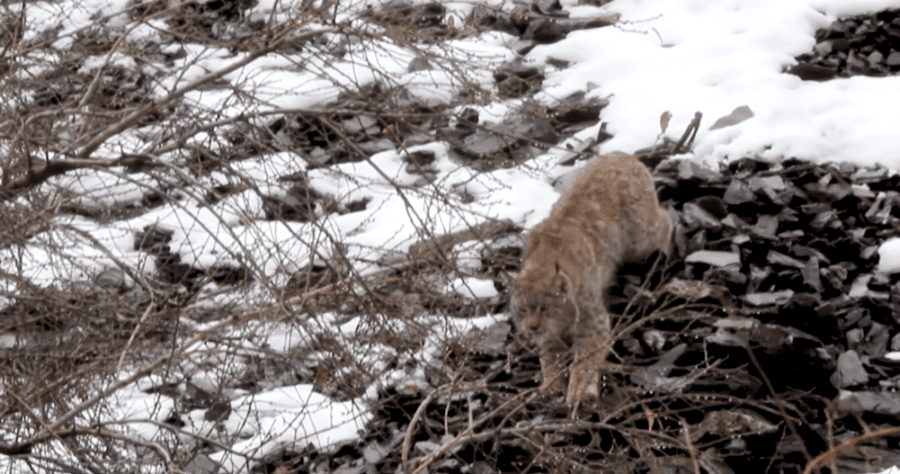Three years ago, a filmmaker set out to document the attempt to restore a neglected Zambian game reserve and its people. Then he was drawn personally into this holistic approach to conservation, a combination of agriculture and aquaculture, micro-capitalism, female empowerment, primary education, wildlife biology, policing and sustainable hunting, all fueled by creativity, perseverance, generosity, teamwork and one family’s investment.
“When we first arrived here in the Luano, in November 2015, it was like Africa a hundred or two hundred years ago. The people had nothing. They needed our help.”
When the cameras started rolling, back in May 2017, those were the first words spoken by third-generation Zambian professional hunter Alister Norton, now 42. Over the next three years, we documented the Norton family’s efforts to help a diminished people, the Soli, to rise again and to restore their wildlife in a war against poaching. But good, honest efforts often aren’t easy, or even necessarily successful.
Meet the Nortons
At a wildlife conference in Atlanta, in 2016, Roland Norton, Alister’s dad, told me about his family’s attempts to turn around a depleted GMA, Game Management Area, in Zambia. GMA is the Zambian government’s term for a safari hunting area—the Africa with no fences, few roads, fewer people and large populations of game. Roland, at 64 years of age, was about to retire from managing an import/export business tied to Zambian copper mining. He wanted to live his passion for safari, something he had enjoyed for more than 30 years, by becoming a professional hunter and safari operator.
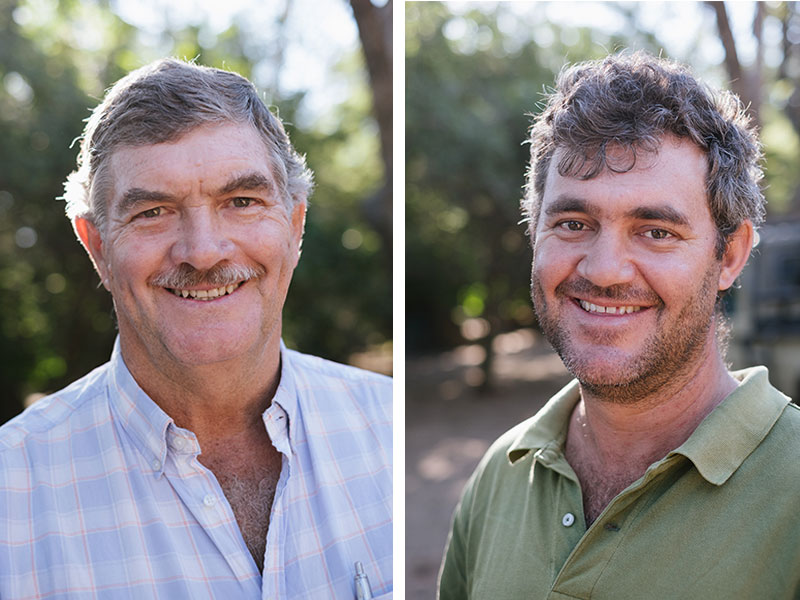
Roland and Alister Norton. Their wives, Anne and Kendal, are fully hands-on in the Lower Luano as well. Tony Bynum photos
Wildlife and conservation run in the Norton family. Roland’s father, after serving in the Royal Navy on HMS Hood, emigrated to what was then Northern Rhodesia and joined the game department. He helped mark out the country’s first national parks and taught his son the ethics of sustainable hunting. Roland in turn developed a desire to show visiting hunters the now re-christened country of Zambia’s wildlife-rich GMAs, including the Luano, where in the 1980s he had shared a camp and clients with professional hunter A.B. Du Plooy.
Working with the Soli people to revitalize the Lower Luano GMA is a family campaign. Roland’s wife, Anne, and Alister’s wife, Kendal, are in it up to their eyebrows as well. Anne is the de facto CFO, juggling the needs of the day with the reality of the bank balance. Almost always at loggerheads with her men, she keeps everyone grounded. “We always don’t have enough money to pay for all the projects up front, but we have enough coming in to keep things moving forward,” she told me. “Al and I always want to do more, faster,” Roland adds. “As a family, we sit down and discuss the projects, both old and new, to determine our work schedule. Whether it be bore-holes, schools, clinics or scout camps, the final word comes from Anne. It all depends on funds.”
Alister and Kendal have two young children, but Kendal is committed as well—she manages the provisioning and logistics for every part of what has swelled into a massive undertaking.
The Luano: recent history
The Luano GMA lies north of the Zambezi River in the corner where Zambia meets Zimbabwe and Mozambique. It originally encompassed more than 2 million acres and was a haven for wildlife. Rift-valley cliffs formed the northern boundary and held in large populations of plains game as well as rhino and elephant. Sizable herds of Cape buffalo roamed along the meandering Lunsemfwa River. Today, the zone has been split along the river into the Upper Luano GMA and the Lower Luano GMA. The Nortons have contracted with the government of Zambia to operate in the Lower Luano.
Safari hunting closures in the Luano in 1988, 2001 and 2002 led to a vacuum in anti-poaching work. In between, the GMA had a safari operator who took but gave little back. The combination spelled disaster for the local people and the wildlife. Poaching increased exponentially. The bushmeat industry became firmly entrenched, with rhino horn and elephant ivory added bonuses. Entire villages of poachers and their families sprang up where game was concentrated. With Zambia’s capital, Lusaka, just a few hours away by truck, the poachers had a ready market. In the Luano’s central town, Shikabeta, population 2,000, depleted soil and unsustainable farming practices drove people to poaching—one man can set hundreds of snares. Entire species were wiped out locally.
The Soli
The Soli people, mostly subsistence farmers, have scratched out a living in the Luano Valley for more than 500 years. They belong to the kingdom of Shikabeta and are led by Her Royal Highness Chieftainess Shikabeta. Realizing the plight of her people, she had searched for a new safari operator. But with an official “game depleted” designation, the Lower Luano GMA was unattractive to any business based on hunting. Still, Shikabeta persisted and found her operator: Roland Norton and his family’s nascent Makasa Safaris Zambia.
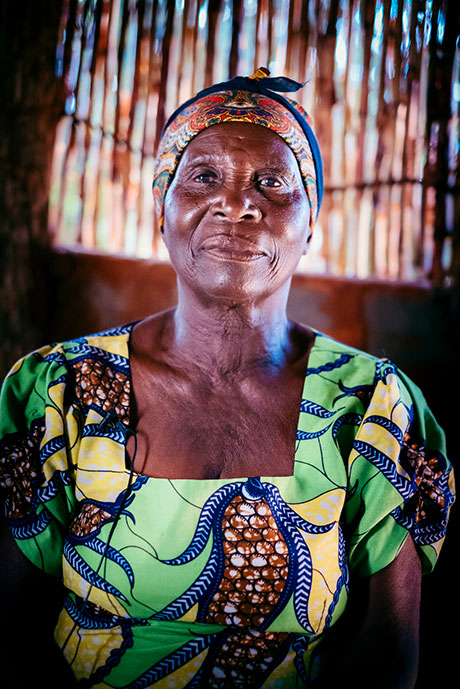
Her Royal Highness Chieftainess Shikabeta, who died in 2018. Tony Bynum photo
No licensed safari hunting had occurred in the Luano for almost two decades when the Nortons first reviewed the area, in 2013. They found rich habitat but little game. With the cash Roland had received for his portion of the export/import company, he and Anne calculated they could invest in the Luano for up to three years with no return. Although there were few animals left, Roland’s memories of large and diverse game herds sealed the deal. In 2015, both generations of the Norton family began a herculean task: to restore the Luano’s wildlife and simultaneously help the local people get their feet back under them. They knew that one could not happen without the other.
Several issues had to be addressed immediately. First, the crops were failing, and children were dying of starvation. Even before funding the initial infrastructure projects they’d agreed on with the community, the Nortons bought and distributed mielie-meal. Alister said, “Look, we couldn’t just tell these people they could no longer go out and set snares to feed their families. They’d say, ‘Then you feed me!’ So we did. And we came up with an alternative protein source, too.”
Protein
The Nortons built a fish farm—six 30,000-gallon above-ground tanks for tilapia and barbel, both native species. Since there was no electricity, they had to install a solar system to generate power for air compressors to keep the fish alive. It was inefficient, but the farm enabled them to provide protein, at cost, to the villagers. Any surplus fish would be sold in Lusaka. The goal was for the farm to expand enough to cover future expenses, including anti-poaching work.
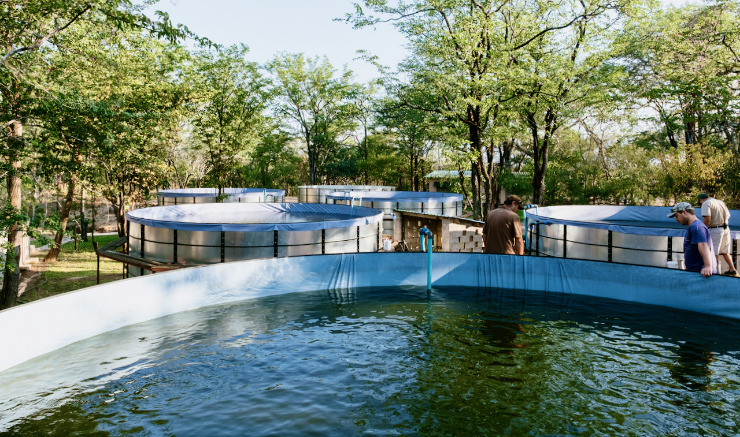
The fish farm—six 30,000-gallon solar-powered tanks for tilapia and barbel, representing protein and income. Author’s photo
November 2015 saw the Soli begin to rise again. Eventually, more than 60 people were hired at the fish farm; among other things, this helped the local economy begin to swing from bartering to cash and from subsistence poaching to raising or buying food.
Schools
Villages in the Lower Luano are spread out along about 120 kilometres (75 miles) of gravel track extending north from the Great East Road, the main conduit between Lusaka and Malawi, to the Lunsemfwa River. Only two of these villages have government primary and secondary schools. Many children had to walk as far as 15 kilometres, 9 miles, each way to class. “Most of them never attended [school] before our arrival,” Anne Norton said. A few went to open-air, thatch-roof bush schools with unpaid teachers who were not formally taught themselves. But without real education, including learning to speak English, children would continue the downward spiral into poverty and bare subsistence, which often included poaching.
In May 2017, my film company shared some of our initial video footage from the Luano with a US-based NGO called ACS, African Children’s Schools. We also struck a deal with the Nortons: We would help find funding for some of the infrastructure projects—schools, clinics and churches—they had agreed to build, but every dollar we found would have to be matched by a dollar for anti-poaching efforts.
Within a week of the initial WhatsApp call between us, the Nortons and ACS, half the money to build three classrooms was in hand. Thus began the construction of hard-sided schools with desks, uniforms and proper supplies. ACS also committed to covering teachers’ salaries. To date, five new classrooms in three new schools have been built. One school, Nygentiki, includes a residence for two teachers. Children are learning not only English, arithmetic and science, but also wildlife conservation and how to minimize wildlife-human conflict.
In both 2018 and 2020, more than 400 school uniforms arrived, paid for by ACS. “I said, ‘praise God!’” said Nygentiki schoolteacher Mutinta Michelo. “I told the parents, when you see your children come home in new uniforms, understand they came from Makasa Safaris [the Nortons] and help from people from abroad [ACS] who care.”
Clinics & transportation
Only two medical clinics staffed by government nurses provided care for almost 5,000 people spread out over the entire Lower Luano GMA—more than 1.2 million acres, or 486,000 hectares. Few in these scattered villages have motor vehicles and most children were not immunized. The Soli suffered rampant malaria, HIV/AIDS and trypanosomiasis, sleeping sickness—illnesses that block the upward movement out of poverty for many families. The loss of the male head of a household to disease often removes the primary financial support, leaving families of two or even three wives and more than 10 children.
The Nortons organized transport to bring the nurses to each village, once a month, with medicines and vaccinations. Roland said, “The children need proper medical care. We need a 100% buy-in by the entire community. As they see our commitment, overseen by Chieftainess Shikabeta, we can create real partnerships.”
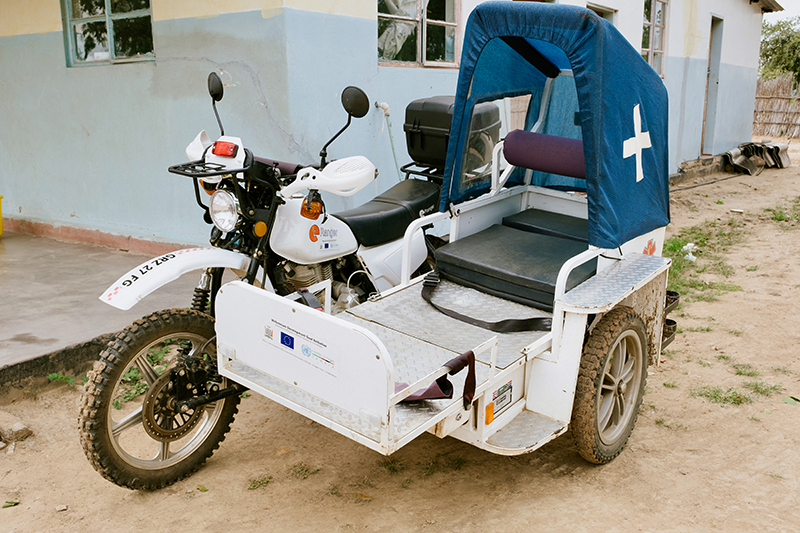
Medical transport, Luano-style. Tony Bynum photo
Farming challenges
On day one, the Nortons learned—among other things—that there was no way to transport surplus crops, if any, to market. On day two, they identified poor farming practices that led to consistent crop failures. “Each year [farmers] would save some seed and use it the next season. Unfortunately, their seed quality had deteriorated. Add substandard soil, little fertilizer and unpredictable rains, and many farmers had a tough go of it,” Roland said.
He visited a supplier in Lusaka to ask for a sample of high-quality maize seed to show to Soli farmers. The sample, he was told, would be ready in a week. When Roland returned, the office secretary said it was waiting on the loading dock. There, an employee pointed it out—an entire pallet of top-quality maize seed.
I didn’t order a pallet, Roland said; the villagers can’t afford this! But it was a gift from the seed company—the owners were moved by the efforts to help the community.
Around this time, the government of Zambia began to offer farmers low-cost basic packages of seed, urea and fertilizer. But the money ran out and the program never made it to the people of the Lower Luano, who only learned they would not receive these packages just as the planting season was beginning. Since the donated pallet of seed could only go so far, the Nortons created a private version of the government plan. They bought and trucked in the materials and provided it to farmers at cost.
But raising good crops here still isn’t simple. Dominque Tombo, a subsistence farmer along the confluence of the Lunsemfwa and Lukusashi Rivers, told me, “I plant for my family maize. I plant one-third for my family. I plant for one-third for weather or drought or army worms. I plant one-third for the baboons who come and eat.”
Old fishing nets and thornbush fences ring his fields. Once the maize has reached maturity, two or three of his eight children sit in machans, platforms eight or 10 feet off the ground, to watch for baboons. A small fire burns below each platform, to protect against lions. (A few pockets of plains game had survived the onslaught of poaching, evidently enough to support a small resident pride of lions.) And kids as young as 5 sit out all night with stout poles to ward off hippos that come from the river to raid the crops.
Another gift
After the gift of a pallet of seed corn, Roland got a call from a friend who owns a Honda motorcycle dealership in Lusaka. He had taken delivery of six off-brand dirt bikes. The Honda district manager gave him an ultimatum: Get rid of the bikes or lose the franchise. The dealer gave all six bikes to the Luano project, where they’re now used by anti-poaching game scouts.
Child brides
It takes 30 bags of maize to feed a family of 10 for a year in the Luano. Since farming is never a sure thing, some families resort to selling daughters who have reached puberty and can have children. Some are only 12 years old. The buyers are typically men of 30 to 45 years; many already have one or more wives and children. With a life expectancy of around 45-50 years for men in the bush, these young wives, now with five or six of their own children, are often left to fend for themselves when their husbands die.
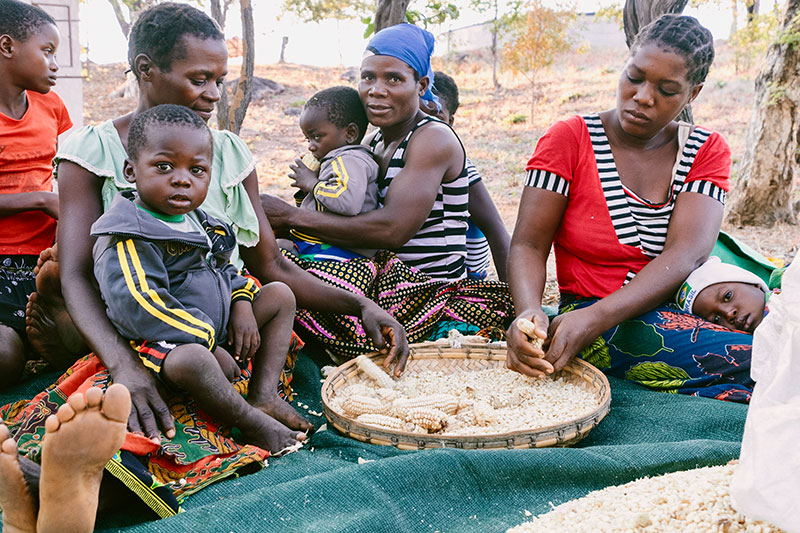
Maize—corn—is a staple crop throughout much of Southern Africa. Tony Bynum photo
The price of such a daughter? Usually about 30 bags of maize.
The Luano offers a host of natural perils, too. For many people, the Lunsemfwa River is the main source of water. In 2016, Godfrey Mwiba, the chief game scout based at the fish farm, received a radio call no parent wants to hear: His 11-year-old daughter had been taken by a crocodile.
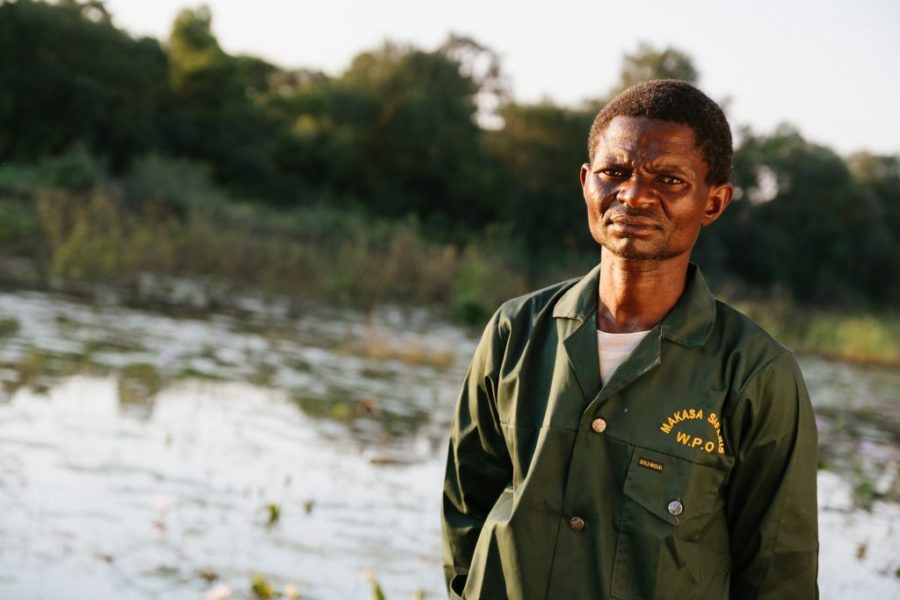
Godfrey Mwiba, now chief game scout for the district. Tony Bynum photo
“We were cleaning our dishes at the edge of the river. Then I heard a splash and scream. I couldn’t believe it. A crocodile grabbed my daughter,” said Godfrey’s wife Louise.
Godfrey arrived with a boat, extra staff and a Kalashnikov rifle. They found his daughter face-down in the water with the crocodile alongside. The croc charged the boat. They killed it with the rifle. Godfrey jumped into the water and retrieved his daughter’s body. When they dragged the croc from the river, they saw that it was completely emaciated—nothing but skin, teeth and bones. A snare around its neck had cut in so deeply that it blocked food passage down its esophagus. Starving, the croc was looking for an easy meal.

The snared crocodile. Makasa Safaris photo
“Poachers killed my daughter,” said Godfrey—the snare had led to his daughter’s death. It was another reminder of how poaching affects every thread of life in the Luano.
Rampant poaching
Wire snares kill indiscriminately. It’s not uncommon in the Lower Luano to see baboons or warthogs that are missing a hand or hoof, or to find the tracks of a maimed leopard. They are the lucky ones who escaped the slow death of a snare.
Roland Norton says, “When a male antelope, with horns, pokes his head into a snare, almost always the horn will make contact with the wire, creating a sound not heard in nature. The antelope stops and backs away, out of the snare. The young ones and the females, without the horns, aren’t so lucky. When they feel the wire around their necks, their flight instinct kicks in. Almost always they’re caught and die in the snare.”
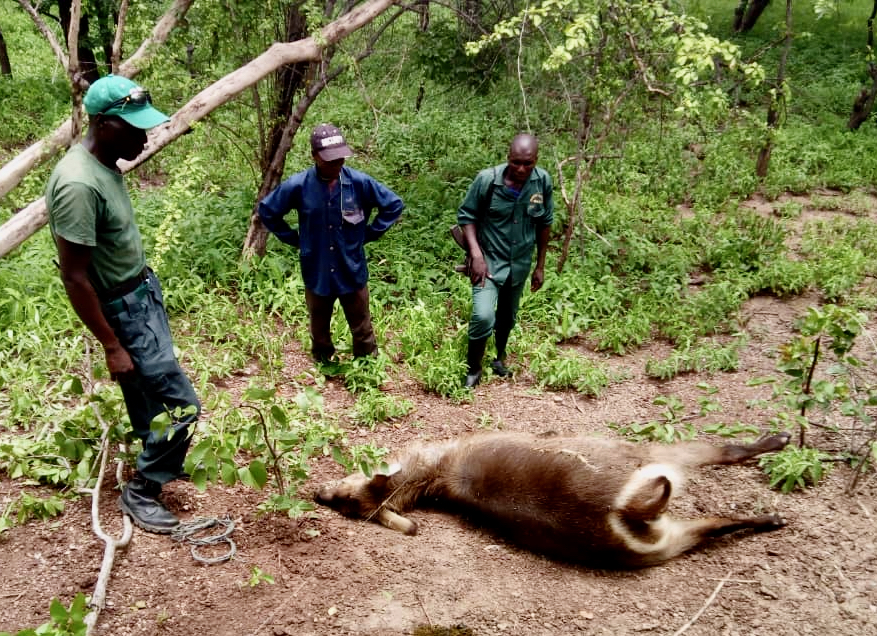
A female waterbuck killed by a poacher’s snare. Makasa Safaris photo.
In early 2015, prior to the Nortons’ arrival, only eight game scouts were patrolling the GMA. They were not well equipped and sometimes received no wages for up to a year. Today, there are more than 60 full-time scouts, trained by Zambia National Parks & Wildlife and authorized to carry firearms. The Nortons provide their kit—surplus military uniforms from South Africa, boots, radios and rations—and regular wages. But because of budget limits not all the scouts carry firearms. The Nortons looked to complement the handful of government-issued assault rifles, but in Zambia even a basic single-shot shotgun costs about $350.
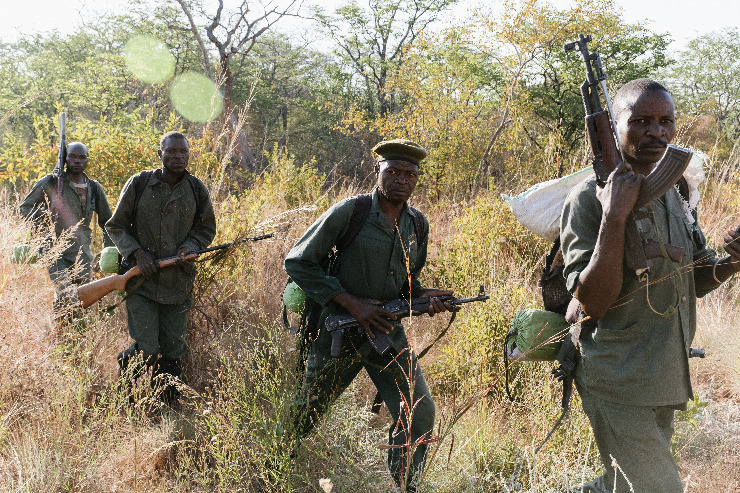
A Luano anti-poaching patrol. There are now 60 game scouts in the GMA where before there were only eight. Tony Bynum phot
Peer pressure
Once the new patrols had pushed the organized bushmeat gangs to the fringes of the GMA, the game scouts could deal with the local variety of poaching—subsistence. Subsistence poachers lay out a dozen or so snares around a spring or a section of river close to home. (Although the fish farm and the maize provide food, people always want more, especially meat.) Any poacher faces stiff sentences and Zambian prisons are not fun places; putting a family member or neighbor away can leave a game scout in a difficult spot. But there was solution to this, too: trail cameras.
Trail cameras help determine the age, health and numbers of animals. The Nortons re-purposed their cameras. Instead of pulling snares as they were found, game scouts began placing cameras on the trails in and out of the poaching areas, then posting pictures of these local poachers throughout the villages. The community made sure the poaching ceased.
Jaco Swanepoel, Makasa Safaris Zambia’s general manager, told me, “We offer incentives for information or for snares or guns turned in. We have two classes of snares—light and heavy duty. We pay 10 kwacha for light and 20 kwacha for heavy snares. A thousand kwacha is paid to anyone offering information that leads to an arrest, or to a poacher who turns in a firearm, no questions asked.”
Embedded with the scouts
In 2018, our filmmakers accompanied a team responding to a poacher’s offer to give up his gun. The poacher lived on the edge of the GMA, in a village known to harbor poachers. At sunset, the scouts headed out in a packed Land Cruiser. In the past, poachers have tried to set up ambushes, so the scouts only enter these outlying villages in the dark of night, and fully armed. As the Toyota pulled off the tar road, we recorded a chorus of guns being cocked.
A kilometre or so down the dirt track, a man in his late 20s appeared and waved us to a stop. This was the poacher. He climbed into the back of the vehicle and directed the scouts to a spot outside the village. There he showed us his rifle hidden in the bush—an ancient bolt-action Lee-Enfield .303 army rifle. Makasa staff and the game scouts pondered how this fellow could have found cartridges in a country where all ammunition, sporting as well as military, is tightly controlled.
It seemed this guy had already done time for poaching. Asked why he wanted to turn himself in, he replied, “I don’t want to go back to prison. I want to start a charcoal business.” Unfortunately, like poaching, making charcoal—cutting and charring timber—also threatens the Luano and its wildlife.
Our cameras, lights blazing in the bush, filmed Makasa staff counting out 1,000 kwacha—about $55—and handing the cash to the poacher. Blackson, a former top poacher turned game scout, called out, in Soli, “See, we told you if you work with us you will be rewarded.” Ex-poachers are expected to become informants and provide anti-poaching intelligence.
Wildlife response
By October 2018, game scouts were seeing a remarkable increase in animals throughout the GMA, and a virtual explosion in numbers in the few areas that had somehow avoided decades of poaching. Three full breeding seasons had come and gone since the Nortons’ arrival; without snares destroying entire age classes of animals, impala, warthog, bushbuck, kudu and waterbuck began to re-establish localized populations.
As a prelude to launching their legal hunting business, the Nortons had to get Zambia National Parks to do a game count. National Parks said that no funds were available to count game in the Lower Luano. The Nortons reached into the family pockets again and shelled out $10,000 to cover the costs; they also provided vehicles, drivers and food.
Our filmmakers were on hand when National Parks staff returned from their first day of counting. They had seen large numbers of plains game, including a herd of 21 roan and more than hundred each of warthog, impala and kudu. One woman commented that the GMA shouldn’t have been designated “game depleted.” She hadn’t been there two years prior, when it took our camera crew 10 days to find two or three dozen animals of any kind. Still, even with this turnaround, there were no elephant, rhino, hartebeest, puku or sustainably huntable populations of plains game outside those pockets which had defied the poachers.
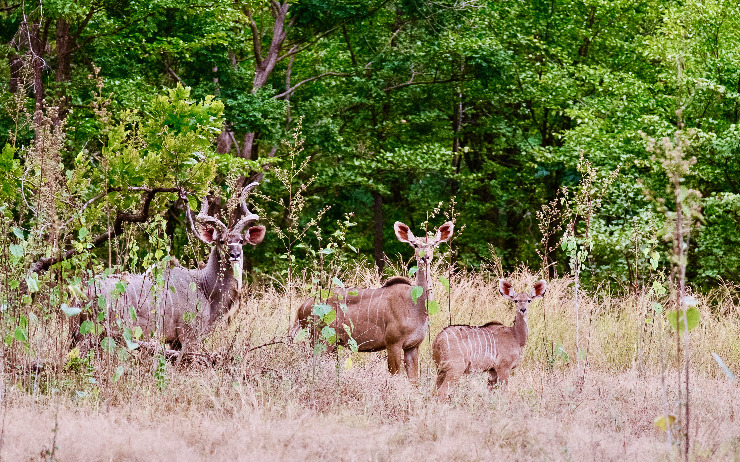
Three years into the war on poaching, wildlife was returning to the Lower Luano—here a kudu bull, cow and calf. Tony Bynum photo
National Parks committed to helping the Nortons re-establish species still missing from the landscape. The only hitch was, again, money. “They told us we can translocate any species of animal and re-introduce them to the Luano. We were given carte blanche to capture animals on other National Parks-managed lands. The only downside was we had to find the funds to pay for it. And trapping and translocating wild animals isn’t easy or cheap,” said Roland.
To date, there are no funds for such trapping and translocation. However, lions have been increasing along with the plains game and in 2019 our camera traps “captured” 17 different leopards. Then, just two months ago, elephants once again began using their old migration route through the Luano to the Luangwa River and the Zambezi. And two elephant bulls and two cows, all elderly, have apparently decided to make a home in a section of the designated wildlife (safari) area; National Parks scouts are keeping tabs on them. Can buffalo be far behind?
In January 2019, National Parks granted the Nortons’ Makasa Safaris Zambia a very limited quota for the next hunting season—just 36 animals. Most of the quota was for impala and warthog, but it included several kudu, waterbuck and bushbuck, two each of crocodile and hippo and one roan and one leopard. The first impala ram, taken by an American woman who had learned of the efforts of the Nortons and the Soli people and wanted to help, was presented to Chieftainess Shikabeta.
Hunting allows community members to be employed as camp staff, trackers and skinners. Hunting clients give cash tips to staff. The meat is distributed around the community. (The Nortons and the community decided that those who receive meat have two weeks to eat it, to ensure that legal meat can’t be used to hide poaching.) Permitted, regulated hunting has become another source of income for the people of Shikabeta. Even more important, it has created a strong incentive for people to defend their renewable natural resources in order to protect and grow their own prosperity.
An all-angles approach
To stop the poaching, the Nortons knew they would have to attack the community’s problems from all angles. Since we began filming, a modest local economy has emerged. Alongside the fish farm, the various subsidies and hunting-related jobs, the Nortons also created a “soft loan” program that offers zero-interest, short-term money to local women, to let them start their own businesses. (Many of the men spend their paychecks on alcohol and prostitutes, leaving the women to feed themselves and their children.) Small shops have popped up in the villages, many run by women.
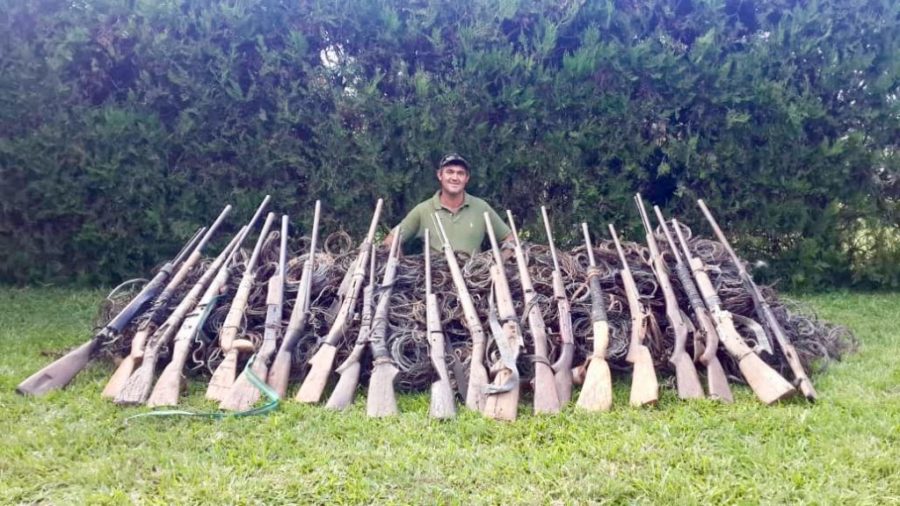
Alister Norton and a haul of snares and illegal guns from the early days of the war against poaching in the Lower Luano. Roland Norton photo
Over the past four years, the game scouts have found and confiscated more than 15,000 wire snares along with about 450 illegal firearms, mostly homemade shotguns and muzzleloaders. While filming in the Luano this past December, we saw a pile of these snares in storage at the fish farm. Jaco Swanepoel said they toss them into the concrete whenever they pour a foundation. This gave me an idea.
Re-purposing for good
Each snare removed from the wild is an animal saved. The idea was to take this a step further: Fashion the snares into bracelets, for men and women. Each bracelet sold would represent the conservation of wildlife; it would also contribute to the Luano’s new business model based on biodiversity and sustainability. The bracelets would appeal to people who care about wildlife and wild places, be they photo tourists, safari hunters or anybody who wants to make our planet a better place. Our non-profit educational company, the Shepherds of Wildlife Society, has hired local women to create these bracelets, and is now also helping to fund the soft loan program.
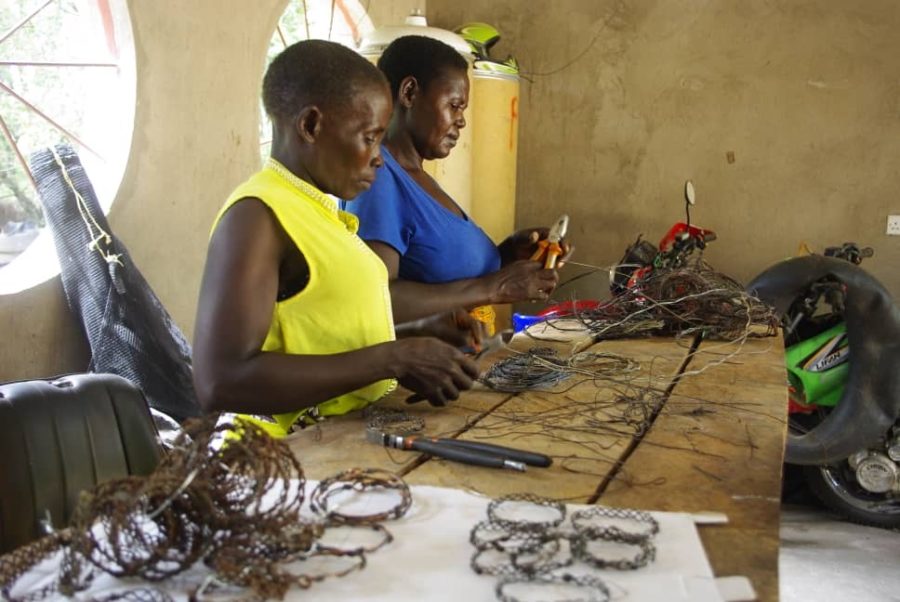
Soli ladies turning snares into bracelets. Makasa Safaris photo.
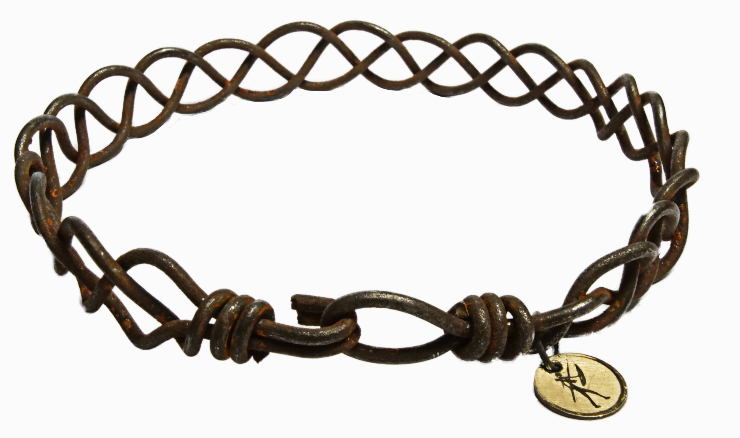
The finished product. Shepherds of Wildlife Society photo
Today, not only is an unusual alliance—the Soli people, the Norton family, Makasa Safaris Zambia, ACS, the Shepherds of Wildlife and Zambia National Parks & Wildlife—working together in conservation, it is also uplifting, educating and empowering a generation of women and children in a remote part of Southern Africa.
Positive change but threats remain
The people of the Luano are seeing positive change. The quality of their lives is improving. As filmmakers, we have watched the Nortons and their staff become part of the community, helping to solve problems and providing hope. The wildlife has responded as well. As Roland Norton says, “It’s amazing what Mother Nature can do if you remove the impediments created by Man.”
The Kingdom of Shikabeta and Zambia National Parks & Wildlife have been so pleased with these results that they granted the Nortons a 20-year safari contract with an automatic five-year renewal for the Lower Luano GMA. This is unheard of in Zambia, where typical GMA tenures are usually seven to 10 years. Equally remarkable was that Chieftainess Shikabeta and her royal council awarded the Nortons a 99-year lease on the lands under the fish farm and their safari camp.
But threats still exist. Illegal logging, charcoal production, mining, development and corruption abound on the edges of the Luano. The Nortons estimate that poaching has been reduced by upwards of 80%, but the gangs they displaced reportedly have contracts out on their lives. “We’ve identified the ambush points coming into and out of the GMA. We all carry firearms when we travel. You can’t let your guard down,” said Roland.
The word is out, though. While interviewing a charcoal maker on edge of the GMA in front of our cameras, Alister Norton asked the man, in Soli, if he goes into the Luano to poach. The man had no idea who Alister was, but he quickly replied, “No, no!” He then placed his forearms over each other, creating an X. He said, “I don’t want to go to prison.”
The film
Our film, Killing the Shepherd, is nearly finished. It is about hope and success and partnerships, as we document the Solis’ and Nortons’ tremendous efforts to restore and conserve an ecosystem and its people. We hope it will help viewers better understand how an indigenous community, the shepherd of its domain, can realize value from renewable natural resources by utilizing them well. (Our drone footage of forest areas may interest wildlife researchers, but none has yet come forward.)
The film does not gloss over some of the tragedies of this remote corner of Africa. Disease, child brides and even the deaths of two chiefs under mysterious circumstances loom large. Despite the pandemic, as this story is being read, we hope to be back in the Luano to wrap up filming. But instead of closing the film with the community’s annual larder festival, held on the last Saturday of July, I’m now thinking we’ll try to find those resident elephants for our finale.
Tom Opre’s lifework is educating the public on wildlife conservation and stewardships. He is the founder and CEO of the Shepherds of Wildlife Society, a non-profit made up of wildlife filmmakers and photographers, with a mission to promote public understanding of the critical importance of wildlife conservation and habitat stewardship. Opre has produced and/or directed national film projects for Fortune 500 companies and television. Currently, he produces The Wildlife Conservation Project, which examines the future of the world’s wildlife and appears on Amazon Prime and various social media platforms. Opre’s YouTube channel has logged more than 26 million views. He wrote “The Reality of Grizzly Bears” in the January ’20 issue of CFL.
Banner photo: Luano poachers’ snares repurposed into fund-raising conservation bracelets. Tony Bynum photo
The post Saving Wildlife—and People—One Snare at a Time appeared first on Conservation Frontlines.
The views expressed by the editors, authors or users of this linked article are expressly theirs, and do not necessarily reflect the policies or opinions of Dallas Safari Club, its employees, members or assigns. Any concerns about a site user’s post should be addressed appropriately to that person. Any concerns about an advertiser, a user or any content on this site should be addressed to social@dscnortheast.org.

